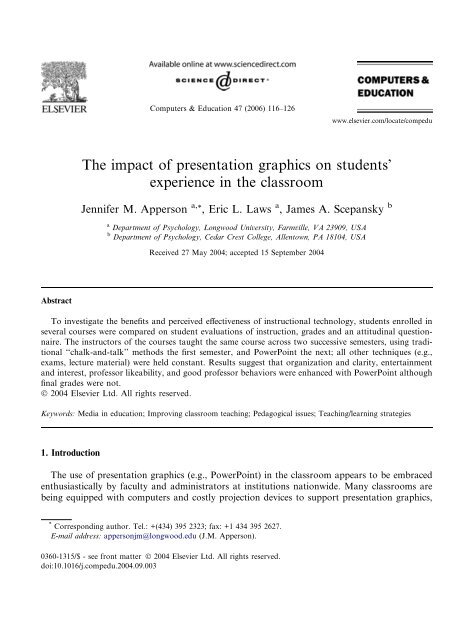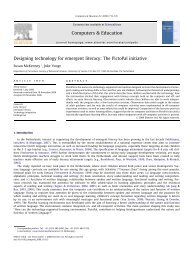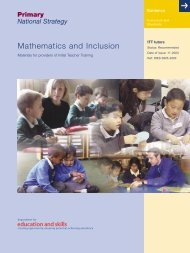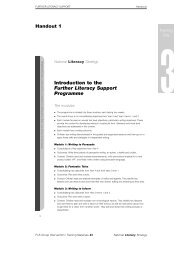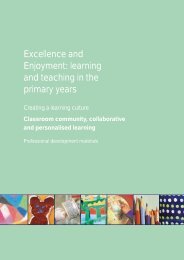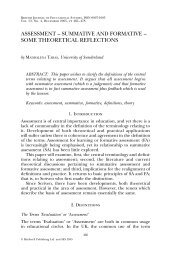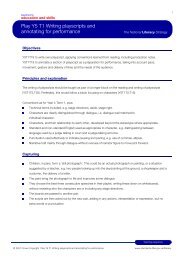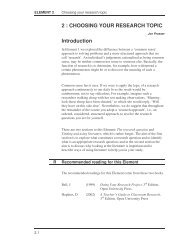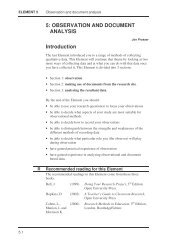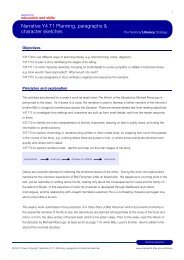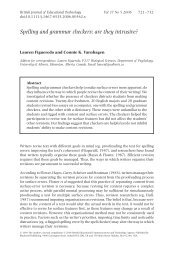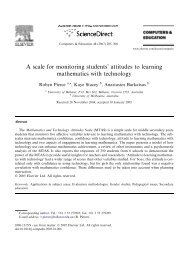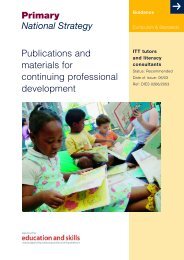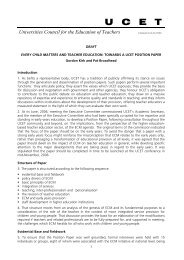The impact of presentation graphics on students experience in - PGCE
The impact of presentation graphics on students experience in - PGCE
The impact of presentation graphics on students experience in - PGCE
Create successful ePaper yourself
Turn your PDF publications into a flip-book with our unique Google optimized e-Paper software.
120 J.M. Appers<strong>on</strong> et al. / Computers & Educati<strong>on</strong> 47 (2006) 116–126Table 1Means, standard deviati<strong>on</strong>s and multivariate analysis <str<strong>on</strong>g>of</str<strong>on</strong>g> variance F ratios <strong>on</strong> <str<strong>on</strong>g>impact</str<strong>on</strong>g> <str<strong>on</strong>g>of</str<strong>on</strong>g> <str<strong>on</strong>g>presentati<strong>on</strong></str<strong>on</strong>g> <str<strong>on</strong>g>graphics</str<strong>on</strong>g> surveyitems as a functi<strong>on</strong> <str<strong>on</strong>g>of</str<strong>on</strong>g> <str<strong>on</strong>g>presentati<strong>on</strong></str<strong>on</strong>g> format used <strong>in</strong> class: chalk and talk (fall, 2002) vs. PowerPo<strong>in</strong>t (spr<strong>in</strong>g, 2003)Questi<strong>on</strong> (1, str<strong>on</strong>gly disagree, 7, str<strong>on</strong>gly agree)Percepti<strong>on</strong>s <str<strong>on</strong>g>of</str<strong>on</strong>g> current class <strong>experience</strong>In reference to the <strong>in</strong>structorÕs <str<strong>on</strong>g>presentati<strong>on</strong></str<strong>on</strong>g> style, it waseasy to determ<strong>in</strong>e the relative importance <str<strong>on</strong>g>of</str<strong>on</strong>g> terms andc<strong>on</strong>cepts (i.e., which covered material was moreimportant)<str<strong>on</strong>g>The</str<strong>on</strong>g> <strong>in</strong>structor was able to stay focused <strong>on</strong> the lecturematerial (e.g., he/she did not skip around and ‘‘go <strong>on</strong>tangents’’)It was easy for me pers<strong>on</strong>ally to stay focused <strong>on</strong> the lecturematerial<str<strong>on</strong>g>The</str<strong>on</strong>g> <strong>in</strong>structor was effective <strong>in</strong> ma<strong>in</strong>ta<strong>in</strong><strong>in</strong>g <strong>students</strong>Õ<strong>in</strong>terest <strong>in</strong> the lecture material<str<strong>on</strong>g>The</str<strong>on</strong>g> <strong>in</strong>structor used time effectively to balance lecture anddiscussi<strong>on</strong><str<strong>on</strong>g>The</str<strong>on</strong>g> <strong>in</strong>structor typically appears to be well prepared forclassGeneral preferences for <str<strong>on</strong>g>presentati<strong>on</strong></str<strong>on</strong>g> techniqueI prefer classes where the <strong>in</strong>structor spends the majority <str<strong>on</strong>g>of</str<strong>on</strong>g>class time lectur<strong>in</strong>gI prefer classes where the <strong>in</strong>structor spends the majority <str<strong>on</strong>g>of</str<strong>on</strong>g>class time facilitat<strong>in</strong>g discussi<strong>on</strong>I prefer classes where the <strong>in</strong>structor follows an explicitoutl<strong>in</strong>e (i.e., prefer to know where you are at all times)I prefer classes where the <strong>in</strong>structor presents material <strong>in</strong>class that is not <strong>in</strong> the textbookAn <strong>in</strong>structor should not feel obligated to cover materialthat is <strong>in</strong> the textbook unless <strong>students</strong> express that theydo not understand the material<str<strong>on</strong>g>The</str<strong>on</strong>g> use <str<strong>on</strong>g>of</str<strong>on</strong>g> PowerPo<strong>in</strong>t is helpful <strong>in</strong> <strong>in</strong>creas<strong>in</strong>g learn<strong>in</strong>g <strong>in</strong>the classroom<str<strong>on</strong>g>The</str<strong>on</strong>g> use <str<strong>on</strong>g>of</str<strong>on</strong>g> PowerPo<strong>in</strong>t <strong>in</strong>creases student <strong>in</strong>terest(enterta<strong>in</strong>ment value) <str<strong>on</strong>g>of</str<strong>on</strong>g> a college class<str<strong>on</strong>g>The</str<strong>on</strong>g> use <str<strong>on</strong>g>of</str<strong>on</strong>g> PowerPo<strong>in</strong>t can help a student get a better grade<strong>in</strong> the classI generally prefer slides that provide full text <str<strong>on</strong>g>of</str<strong>on</strong>g> the lecturematerial (i.e., everyth<strong>in</strong>g the pr<str<strong>on</strong>g>of</str<strong>on</strong>g>essor wants me to knowis completely written out <strong>on</strong> the slide)I generally prefer slides that provide key phrase outl<strong>in</strong>es <str<strong>on</strong>g>of</str<strong>on</strong>g>the lecture materialI generally f<strong>in</strong>d visual elements (e.g., pictures/charts/<str<strong>on</strong>g>graphics</str<strong>on</strong>g>/maps) helpful <strong>in</strong> PowerPo<strong>in</strong>t <str<strong>on</strong>g>presentati<strong>on</strong></str<strong>on</strong>g>sI f<strong>in</strong>d it helpful for pr<str<strong>on</strong>g>of</str<strong>on</strong>g>essors to read the PowerPo<strong>in</strong>t slidesas they are presentedChalk andtalk(N = 152)PowerPo<strong>in</strong>t(N = 144)M SD M SDF(1,294)5.46 1.30 5.73 1.25 3.305.80 1.36 5.53 1.43 2.734.93 1.50 5.31 1.43 5.12* .265.18 1.27 5.54 1.24 5.77* .275.75 1.26 5.92 1.17 1.526.47 .76 6.61 .79 2.563.94 1.73 4.12 1.74 .774.74 1.51 4.82 1.51 .225.77 1.34 5.98 1.12 2.124.09 1.68 4.25 1.55 .743.45 1.77 3.42 1.80 .025.40 1.34 6.14 .94 29.59*** .635.15 1.39 5.57 1.36 7.08** .304.67 1.43 4.92 1.46 2.255.36 1.57 5.28 1.63 .174.93 1.28 5.10 1.41 1.185.79 1.16 5.90 1.12 .645.35 1.42 5.66 1.30 3.86* .22Effect sizeCohenÕs d
Table 1 (c<strong>on</strong>t<strong>in</strong>ued)Questi<strong>on</strong> (1, str<strong>on</strong>gly disagree, 7, str<strong>on</strong>gly agree)Chalk and talk(N = 152)PowerPo<strong>in</strong>t(N = 144)F(1,294)M SD M SDI f<strong>in</strong>d it helpful for pr<str<strong>on</strong>g>of</str<strong>on</strong>g>essors to use the PowerPo<strong>in</strong>t slides 5.49 1.13 5.68 1.14 1.99as discussi<strong>on</strong> po<strong>in</strong>ts for the lecturesI f<strong>in</strong>d it helpful for pr<str<strong>on</strong>g>of</str<strong>on</strong>g>essors to use decorative4.40 1.39 4.49 1.61 .24backgrounds <strong>on</strong> PowerPo<strong>in</strong>t slides used for classroomlecturesI f<strong>in</strong>d it helpful for pr<str<strong>on</strong>g>of</str<strong>on</strong>g>essors to use computer-generated 3.62 1.54 3.84 1.78 1.32sounds with PowerPo<strong>in</strong>t <str<strong>on</strong>g>presentati<strong>on</strong></str<strong>on</strong>g>sI f<strong>in</strong>d it helpful when each slide is revealed all at <strong>on</strong>ce 4.13 1.66 3.83 1.82 2.28I f<strong>in</strong>d it helpful when slides are ‘‘animated’’ (i.e., built l<strong>in</strong>e 4.31 1.61 4.86 1.67 8.36** .33by l<strong>in</strong>e) as the lecture progressesI feel that the use <str<strong>on</strong>g>of</str<strong>on</strong>g> PowerPo<strong>in</strong>t <strong>in</strong>hibits discussi<strong>on</strong> 4.03 1.53 3.49 1.64 8.40** .33Dur<strong>in</strong>g lectures us<strong>in</strong>g PowerPo<strong>in</strong>t, I prefer the lights <strong>on</strong> full 2.67 1.46 2.85 1.64 1.03(possibly sacrific<strong>in</strong>g the quality <str<strong>on</strong>g>of</str<strong>on</strong>g> the screen image)Dur<strong>in</strong>g lectures us<strong>in</strong>g PowerPo<strong>in</strong>t, I prefer the lights to be 5.28 1.38 5.44 1.50 .85dimmed, produc<strong>in</strong>g a sharper screen image.Dur<strong>in</strong>g lectures us<strong>in</strong>g PowerPo<strong>in</strong>t, I prefer the lights turned<str<strong>on</strong>g>of</str<strong>on</strong>g>f, produc<strong>in</strong>g the sharpest screen image4.18 1.94 4.26 1.94 .12Note: * p < .05. ** p < .01. *** p < .001.J.M. Appers<strong>on</strong> et al. / Computers & Educati<strong>on</strong> 47 (2006) 116–126 121Effect sizeCohenÕs das both an <strong>in</strong>centive and to allow the participat<strong>in</strong>g <strong>in</strong>structors to enhance their PowerPo<strong>in</strong>t<str<strong>on</strong>g>presentati<strong>on</strong></str<strong>on</strong>g>s with pictures.2.3. ProceduresFive faculty from four separate discipl<strong>in</strong>es (Psychology, Sociology, History and Political Science)agreed to teach a class without <strong>in</strong>structi<strong>on</strong>al technology (‘‘chalk-and-talk’’) <strong>in</strong> the Fall2002 semester and then with <strong>in</strong>structi<strong>on</strong>al technology (PowerPo<strong>in</strong>t) <strong>in</strong> the Spr<strong>in</strong>g 2003 semester.‘‘Chalk and talk’’ methods <strong>in</strong>cluded writ<strong>in</strong>g <strong>on</strong> the blackboard, us<strong>in</strong>g overhead projector, mapsand other materials <strong>in</strong> the classroom dur<strong>in</strong>g regular course lectures and discussi<strong>on</strong>. <str<strong>on</strong>g>The</str<strong>on</strong>g>se facultyused the same textbook, tests and lecture material across the two semesters, the <strong>on</strong>ly differencebe<strong>in</strong>g the use <str<strong>on</strong>g>of</str<strong>on</strong>g> PowerPo<strong>in</strong>t technology to support at least 50% <str<strong>on</strong>g>of</str<strong>on</strong>g> their lectures <strong>in</strong> the Spr<strong>in</strong>g2003 semester. <str<strong>on</strong>g>The</str<strong>on</strong>g> classes were Introducti<strong>on</strong> to Psychology, Foundati<strong>on</strong>s <str<strong>on</strong>g>of</str<strong>on</strong>g> Western Civilizati<strong>on</strong>,American Government and Politics, Pr<strong>in</strong>ciples <str<strong>on</strong>g>of</str<strong>on</strong>g> Sociology, and Research Methods <strong>in</strong> Psychology.Participat<strong>in</strong>g faculty were provided <strong>in</strong>structi<strong>on</strong> <strong>in</strong> the use <str<strong>on</strong>g>of</str<strong>on</strong>g> PowerPo<strong>in</strong>t and a scanner toassist <strong>in</strong> their PowerPo<strong>in</strong>t <str<strong>on</strong>g>presentati<strong>on</strong></str<strong>on</strong>g> development.3. ResultsCollapsed across classes, a Multivariate Analysis <str<strong>on</strong>g>of</str<strong>on</strong>g> Variance (MANOVA) was c<strong>on</strong>ductedassess<strong>in</strong>g the effects <str<strong>on</strong>g>of</str<strong>on</strong>g> <str<strong>on</strong>g>presentati<strong>on</strong></str<strong>on</strong>g> format (PowerPo<strong>in</strong>t vs. ‘‘chalk and talk’’) <strong>on</strong> the 28 survey
122 J.M. Appers<strong>on</strong> et al. / Computers & Educati<strong>on</strong> 47 (2006) 116–126Table 2Means, standard deviati<strong>on</strong>s and multivariate analysis <str<strong>on</strong>g>of</str<strong>on</strong>g> variance F ratios <strong>on</strong> items from university-wide studentassessment <str<strong>on</strong>g>of</str<strong>on</strong>g> teach<strong>in</strong>g <strong>in</strong>strument as a functi<strong>on</strong> <str<strong>on</strong>g>of</str<strong>on</strong>g> <str<strong>on</strong>g>presentati<strong>on</strong></str<strong>on</strong>g> format used <strong>in</strong> class: chalk and talk (fall, 2002) vs.PowerPo<strong>in</strong>t (spr<strong>in</strong>g, 2003)Questi<strong>on</strong>Chalk andtalk(N = 104)PowerPo<strong>in</strong>t(N = 95)F(1,197)Effect sizeCohenÕs dM SD M SDCompared to other courses... (1, much less; 2, less; 3, average; 4, more; 5, much more)How much read<strong>in</strong>g was required? 3.66 .83 3.45 .82 3.23How much writ<strong>in</strong>g was required? 3.27 .91 3.36 .92 .47How much other work was required? 2.91 .93 3.15 .83 3.52How difficult was the course? 3.55 .77 3.62 .69 .49How hard did you work? 3.52 .82 3.67 .75 1.90Attitudes: (1 = no, def<strong>in</strong>itely not; 2 = no, probably not; 3 = neutral; 4 = yes, probably; 5 = yes, def<strong>in</strong>itely)Do you have a more positive attitude about this subject 3.82 1.01 3.80 1.13 .01after tak<strong>in</strong>g this course?Would you like to take another course from this <strong>in</strong>structor? 4.04 1.17 4.35 .92 4.25* .29Workload: (1 = n<strong>on</strong>e, 2 = 1–3, 3 = 4–6, 4 = 7–9, 5 = more than 9)On the average, how many hours per week did you spend 2.64 .71 2.82 .85 2.55prepar<strong>in</strong>g for class?Overall evaluati<strong>on</strong>: (1, poor; 2, below average; 3, average; 4, above average; 5, excellent)Rate the <strong>in</strong>structor overall 4.10 .92 4.34 .82 3.77* .27Rate the course overall 3.60 .96 3.72 .94 .79Rate your learn<strong>in</strong>g overall 3.64 .86 3.76 .87 .86Assessment <str<strong>on</strong>g>of</str<strong>on</strong>g> teach<strong>in</strong>g: the <strong>in</strong>structor...(1, hardly ever; 2, occasi<strong>on</strong>ally; 3, sometimes; 4, frequently; 5, almost always)Promoted discussi<strong>on</strong> 4.31 .96 4.51 .67 2.81Presented material <strong>in</strong> a clear and organized way 4.37 .98 4.70 .64 7.79** .39Encouraged <strong>students</strong> to express themselves 4.35 .94 4.53 .70 2.31Was enthusiastic about the subject matter 4.67 .70 4.82 .41 3.20C<strong>on</strong>sidered issues from an ethical perspective 4.40 .74 4.55 .67 2.04Gave exams that covered important material 4.45 .79 4.58 .65 1.53Spoke with expressiveness and variety <strong>in</strong> t<strong>on</strong>e <str<strong>on</strong>g>of</str<strong>on</strong>g> voice 4.50 .85 4.70 .55 3.63Dem<strong>on</strong>strated the significance <str<strong>on</strong>g>of</str<strong>on</strong>g> the subject matter 4.45 .79 4.68 .62 5.26* .32Made it clear how each topic fit <strong>in</strong>to the course 4.45 .84 4.67 .57 4.69* .30Offered explanati<strong>on</strong>s for grades earned 4.31 .94 4.46 .82 1.54Summarized material <strong>in</strong> a way that aided retenti<strong>on</strong> 4.19 .89 4.44 .76 4.51* .30Clearly stated the objectives <str<strong>on</strong>g>of</str<strong>on</strong>g> the course 4.32 .77 4.52 .67 3.77* .27Expla<strong>in</strong>ed course material clearly 4.30 .87 4.56 .68 5.45* .33Related course material to life situati<strong>on</strong>s 4.33 .90 4.46 .76 1.33Gave exams that were based <strong>on</strong> course c<strong>on</strong>tent and 4.43 .81 4.63 .65 3.59requirementsEncouraged the c<strong>on</strong>siderati<strong>on</strong> <str<strong>on</strong>g>of</str<strong>on</strong>g> ideas from diverse 4.34 .84 4.41 .81 .40perspectivesProvided feedback <strong>on</strong> exams and papers <strong>in</strong> a timely 4.34 .90 4.43 .71 .55fashi<strong>on</strong>Offered the opportunity to practice or apply skills throughexercises and projects3.79 1.15 4.21 .92 8.10** .40
Table 2 (c<strong>on</strong>t<strong>in</strong>ued)Questi<strong>on</strong>Chalk andtalk(N = 104)PowerPo<strong>in</strong>t(N = 95)F(1,197)M SD M SDWas available for c<strong>on</strong>sultati<strong>on</strong> with <strong>students</strong> outside 4.39 .78 4.56 .60 3.06<str<strong>on</strong>g>of</str<strong>on</strong>g> classGave projects, tests, or assignments that required 3.98 1.04 4.26 .90 4.14* .28critical th<strong>in</strong>k<strong>in</strong>g or problem-solv<strong>in</strong>gGave projects, tests, or assignments that required 3.88 1.14 4.17 .99 3.75* .27orig<strong>in</strong>al or creative th<strong>in</strong>k<strong>in</strong>gWas clear <strong>in</strong> stat<strong>in</strong>g expectati<strong>on</strong>s for papers and 4.39 .90 4.47 .71 .47other assignmentsGave helpful feedback <strong>on</strong> papers and assignments 4.22 .91 4.48 .78 4.71* .30Used <strong>in</strong>structi<strong>on</strong>al technology to enhance3.49 1.51 4.78 .49 62.86*** 1.14<str<strong>on</strong>g>presentati<strong>on</strong></str<strong>on</strong>g>sGave projects or assignments that required the use 3.83 1.27 4.41 .84 14.37*** .54<str<strong>on</strong>g>of</str<strong>on</strong>g> computersDem<strong>on</strong>strated how technology can be used tosearch for <strong>in</strong>formati<strong>on</strong>, present <strong>in</strong>formati<strong>on</strong>, orsolve problems3.36 1.39 4.16 .95 22.12*** .67Note: * p < .05. ** p < .01. *** p < .001.J.M. Appers<strong>on</strong> et al. / Computers & Educati<strong>on</strong> 47 (2006) 116–126 123Effect sizeCohenÕs ditems related to <strong>students</strong>Õ percepti<strong>on</strong>s <str<strong>on</strong>g>of</str<strong>on</strong>g> effective classroom practices (<str<strong>on</strong>g>The</str<strong>on</strong>g> Impact <str<strong>on</strong>g>of</str<strong>on</strong>g> Presentati<strong>on</strong>Graphics Student Survey). Analyses <strong>in</strong>dicate that <strong>students</strong> who completed the class dur<strong>in</strong>g thesemester <strong>in</strong> which PowerPo<strong>in</strong>t was used to present class material were more likely to feel that itwas easy to stay focused <strong>on</strong> lecture material, that the <strong>in</strong>structor ma<strong>in</strong>ta<strong>in</strong>ed student <strong>in</strong>terest <strong>in</strong>the course material, that PowerPo<strong>in</strong>t is helpful <strong>in</strong> <strong>in</strong>creas<strong>in</strong>g classroom learn<strong>in</strong>g, and that Power-Po<strong>in</strong>t <strong>in</strong>creases the <strong>in</strong>terest level <str<strong>on</strong>g>of</str<strong>on</strong>g> a college class; they were also less likely to believe that PowerPo<strong>in</strong>t<strong>in</strong>hibits classroom discussi<strong>on</strong> (See Table 1). As can be seen from Table 1, most <str<strong>on</strong>g>of</str<strong>on</strong>g> the effectsizes (CohenÕs d) were medium with at least <strong>on</strong>e be<strong>in</strong>g a large effect size (the item stat<strong>in</strong>g ‘‘PowerPo<strong>in</strong>tis helpful <strong>in</strong> <strong>in</strong>creas<strong>in</strong>g learn<strong>in</strong>g <strong>in</strong> the classroom’’).A sec<strong>on</strong>d Multivariate Analysis <str<strong>on</strong>g>of</str<strong>on</strong>g> Variance (MANOVA) was c<strong>on</strong>ducted assess<strong>in</strong>g the effects <str<strong>on</strong>g>of</str<strong>on</strong>g><str<strong>on</strong>g>presentati<strong>on</strong></str<strong>on</strong>g> format (PowerPo<strong>in</strong>t vs. ‘‘chalk and talk’’) <strong>on</strong> resp<strong>on</strong>ses obta<strong>in</strong>ed from the universitywide,37-item end-<str<strong>on</strong>g>of</str<strong>on</strong>g>-semester student evaluati<strong>on</strong> <str<strong>on</strong>g>of</str<strong>on</strong>g> teach<strong>in</strong>g <strong>in</strong>strument. Analyses <strong>in</strong>dicated that<strong>students</strong> enrolled <strong>in</strong> the PowerPo<strong>in</strong>t classes were more likely than <strong>students</strong> enrolled <strong>in</strong> the ‘‘chalkand talk’’ classes to want to take another class <str<strong>on</strong>g>of</str<strong>on</strong>g>fered by that same pr<str<strong>on</strong>g>of</str<strong>on</strong>g>essor, they rated the pr<str<strong>on</strong>g>of</str<strong>on</strong>g>essormore favorably overall, and they believed the pr<str<strong>on</strong>g>of</str<strong>on</strong>g>essor presented material more clearly,dem<strong>on</strong>strated how each topic fit <strong>in</strong> the course, summarized <strong>in</strong>formati<strong>on</strong> <strong>in</strong> a way that aided <strong>in</strong>their retenti<strong>on</strong>, and used technology effectively to enhance <str<strong>on</strong>g>presentati<strong>on</strong></str<strong>on</strong>g>s (See Table 2). Aga<strong>in</strong>,the effects sizes <str<strong>on</strong>g>of</str<strong>on</strong>g> the significant f<strong>in</strong>d<strong>in</strong>gs were all medium to large.Furthermore, <strong>students</strong> enrolled <strong>in</strong> the PowerPo<strong>in</strong>t classes <strong>in</strong>dicated that the pr<str<strong>on</strong>g>of</str<strong>on</strong>g>essor dem<strong>on</strong>stratedthe significance <str<strong>on</strong>g>of</str<strong>on</strong>g> the subject matter more, more clearly stated the objectives <str<strong>on</strong>g>of</str<strong>on</strong>g> the course,<str<strong>on</strong>g>of</str<strong>on</strong>g>fered more opportunities to apply learned skills through exercises and projects, gave more projectsthat required problem solv<strong>in</strong>g and critical, orig<strong>in</strong>al or creative th<strong>in</strong>k<strong>in</strong>g, gave more helpful
124 J.M. Appers<strong>on</strong> et al. / Computers & Educati<strong>on</strong> 47 (2006) 116–126Table 3Questi<strong>on</strong>s associated with three general areas show<strong>in</strong>g significant differences between use: chalk and talk (fall, 2002) vs.PowerPo<strong>in</strong>t (spr<strong>in</strong>g, 2003)Organizati<strong>on</strong>/clarity/<strong>in</strong>terestIPGQIt was easy for me pers<strong>on</strong>ally to stay focused <strong>on</strong> the lecture materialIPGQ<str<strong>on</strong>g>The</str<strong>on</strong>g> <strong>in</strong>structor was effective <strong>in</strong> ma<strong>in</strong>ta<strong>in</strong><strong>in</strong>g <strong>students</strong>Õ <strong>in</strong>terest <strong>in</strong> the lecture materialIPGQ<str<strong>on</strong>g>The</str<strong>on</strong>g> use <str<strong>on</strong>g>of</str<strong>on</strong>g> PowerPo<strong>in</strong>t is helpful <strong>in</strong> <strong>in</strong>creas<strong>in</strong>g learn<strong>in</strong>g <strong>in</strong> the classroomIPGQ<str<strong>on</strong>g>The</str<strong>on</strong>g> use <str<strong>on</strong>g>of</str<strong>on</strong>g> PowerPo<strong>in</strong>t <strong>in</strong>creases student <strong>in</strong>terest (enterta<strong>in</strong>ment value)<str<strong>on</strong>g>of</str<strong>on</strong>g> a college classSAIPresented material <strong>in</strong> a clear and organized waySAIMade it clear how each topic fit <strong>in</strong>to the courseSAISummarized material <strong>in</strong> a way that aided retenti<strong>on</strong>SAIExpla<strong>in</strong>ed course material clearlyPr<str<strong>on</strong>g>of</str<strong>on</strong>g>essor ‘‘likeability’’SAISAI‘‘Good pr<str<strong>on</strong>g>of</str<strong>on</strong>g>essor behaviors’’IPGQ*SAISAISAISAISAISAIWould you like to take another course from this <strong>in</strong>structor?Rate the <strong>in</strong>structor overallI feel that the use <str<strong>on</strong>g>of</str<strong>on</strong>g> PowerPo<strong>in</strong>t <strong>in</strong>hibits discussi<strong>on</strong>Clearly stated the objectives <str<strong>on</strong>g>of</str<strong>on</strong>g> the courseOffered the opportunity to practice or apply skills through exercises and projectsGave projects, tests, or assignments that required critical th<strong>in</strong>k<strong>in</strong>g or problem-solv<strong>in</strong>gGave projects, tests, or assignments that required orig<strong>in</strong>al or creative th<strong>in</strong>k<strong>in</strong>gGave helpful feedback <strong>on</strong> papers and assignmentsDem<strong>on</strong>strated how technology can be used to search for <strong>in</strong>formati<strong>on</strong>,present <strong>in</strong>formati<strong>on</strong>, or solve problemsNote: SAI, student assessment <str<strong>on</strong>g>of</str<strong>on</strong>g> <strong>in</strong>structi<strong>on</strong>; IPGQ, <str<strong>on</strong>g>impact</str<strong>on</strong>g> <str<strong>on</strong>g>of</str<strong>on</strong>g> <str<strong>on</strong>g>presentati<strong>on</strong></str<strong>on</strong>g> <str<strong>on</strong>g>graphics</str<strong>on</strong>g> questi<strong>on</strong>naire. Except for IPGQ*,all means were higher for PowerPo<strong>in</strong>t c<strong>on</strong>diti<strong>on</strong>.feedback <strong>on</strong> tests and assignments and dem<strong>on</strong>strated how technology can be used to search forand present <strong>in</strong>formati<strong>on</strong> or solve problems to a greater extent than <strong>students</strong> enrolled <strong>in</strong> classesnot us<strong>in</strong>g PowerPo<strong>in</strong>t (see Table 3). Analyses <str<strong>on</strong>g>of</str<strong>on</strong>g> the <str<strong>on</strong>g>impact</str<strong>on</strong>g> <str<strong>on</strong>g>of</str<strong>on</strong>g> the use <str<strong>on</strong>g>of</str<strong>on</strong>g> PowerPo<strong>in</strong>t <strong>on</strong> <strong>students</strong>Õf<strong>in</strong>al grades <strong>in</strong> the classes revealed no significant differences between the classes with and withoutthe use <str<strong>on</strong>g>of</str<strong>on</strong>g> PowerPo<strong>in</strong>t.4. Discussi<strong>on</strong>Although the data <strong>in</strong>dicated that there were no differences <strong>in</strong> grades as a result <str<strong>on</strong>g>of</str<strong>on</strong>g> the use <str<strong>on</strong>g>of</str<strong>on</strong>g>PowerPo<strong>in</strong>t <strong>in</strong> the classroom, there were differences <strong>on</strong> a variety <str<strong>on</strong>g>of</str<strong>on</strong>g> questi<strong>on</strong>s from both the university-wideStudent Assessment <str<strong>on</strong>g>of</str<strong>on</strong>g> Instructi<strong>on</strong> and the Impact <str<strong>on</strong>g>of</str<strong>on</strong>g> Presentati<strong>on</strong> Graphics StudentSurvey questi<strong>on</strong>naire. <str<strong>on</strong>g>The</str<strong>on</strong>g>se questi<strong>on</strong>s tended to group themselves accord<strong>in</strong>g to three generalareas: organizati<strong>on</strong>/clarity/<strong>in</strong>terest, pr<str<strong>on</strong>g>of</str<strong>on</strong>g>essor ‘‘likeability’’, and ‘‘good pr<str<strong>on</strong>g>of</str<strong>on</strong>g>essor behaviors’’ (seeTable 3). For organizati<strong>on</strong>/clarity/<strong>in</strong>terest, <strong>students</strong> resp<strong>on</strong>ded more favorably toward the classestaught with the use <str<strong>on</strong>g>of</str<strong>on</strong>g> PowerPo<strong>in</strong>t. It is <strong>in</strong>terest<strong>in</strong>g to note here that, c<strong>on</strong>sistent with other research,the <strong>students</strong> generally believed that the use <str<strong>on</strong>g>of</str<strong>on</strong>g> PowerPo<strong>in</strong>t facilitated their learn<strong>in</strong>g eventhough grades were not significantly different (Atk<strong>in</strong>s-Sayre et al., 1998; Beets & Lob<strong>in</strong>gier,
J.M. Appers<strong>on</strong> et al. / Computers & Educati<strong>on</strong> 47 (2006) 116–126 1252001; Mantei, 2000; Rank<strong>in</strong> & Hoaas, 2001; Szabo & Hast<strong>in</strong>gs, 2000). Likewise, <strong>students</strong> resp<strong>on</strong>dedthat they liked the pr<str<strong>on</strong>g>of</str<strong>on</strong>g>essor more (rated the pr<str<strong>on</strong>g>of</str<strong>on</strong>g>essor higher overall) and would liketo take another class from the pr<str<strong>on</strong>g>of</str<strong>on</strong>g>essor when PowerPo<strong>in</strong>t was used. Lastly, <strong>students</strong> resp<strong>on</strong>dedmore favorably <strong>in</strong> classes us<strong>in</strong>g PowerPo<strong>in</strong>t to pr<str<strong>on</strong>g>of</str<strong>on</strong>g>essor behaviors seem<strong>in</strong>gly unrelated to the use<str<strong>on</strong>g>of</str<strong>on</strong>g> PowerPo<strong>in</strong>t (e.g., hand<strong>in</strong>g back papers <strong>on</strong> time with helpful feedback, assign<strong>in</strong>g more tasksrequir<strong>in</strong>g critical or creative thought). It seems that the use <str<strong>on</strong>g>of</str<strong>on</strong>g> PowerPo<strong>in</strong>t may have created a generallyfavorable impressi<strong>on</strong> <str<strong>on</strong>g>of</str<strong>on</strong>g> the class and the pr<str<strong>on</strong>g>of</str<strong>on</strong>g>essor while not significantly affect<strong>in</strong>g grades.We speculate that grades are not significantly different because the use <str<strong>on</strong>g>of</str<strong>on</strong>g> PowerPo<strong>in</strong>t <strong>in</strong>deed doesnot significantly affect grades. Rather, it seems that the use <str<strong>on</strong>g>of</str<strong>on</strong>g> PowerPo<strong>in</strong>t makes for a better <strong>experience</strong>for the <strong>students</strong> from their perspective. It is our c<strong>on</strong>tenti<strong>on</strong> that this c<strong>on</strong>fers an enormousbenefit towards educati<strong>on</strong> <strong>in</strong> that <strong>students</strong> like the courses better and therefore have a more favorableattitude toward their educati<strong>on</strong>. We did not collect data <strong>on</strong> attendance and gender, however,we feel that both <str<strong>on</strong>g>of</str<strong>on</strong>g> these might be excellent variables to assess <strong>in</strong> terms <str<strong>on</strong>g>of</str<strong>on</strong>g> the effects <str<strong>on</strong>g>of</str<strong>on</strong>g> Power-Po<strong>in</strong>t <strong>in</strong> the classroom. Presumably, attendance would have an effect <strong>in</strong> that those who attendedshould be more <strong>in</strong>fluenced by the classroom techniques than those who had high absence rates.<str<strong>on</strong>g>The</str<strong>on</strong>g> learn<strong>in</strong>g seems to be the same (although other studies have <strong>in</strong>dicated that grades improvewith <str<strong>on</strong>g>presentati<strong>on</strong></str<strong>on</strong>g> <str<strong>on</strong>g>graphics</str<strong>on</strong>g> and multimedia <str<strong>on</strong>g>presentati<strong>on</strong></str<strong>on</strong>g>s), but the overall <strong>experience</strong> appears tobe more favorable <strong>in</strong> classes taught with <str<strong>on</strong>g>presentati<strong>on</strong></str<strong>on</strong>g> <str<strong>on</strong>g>graphics</str<strong>on</strong>g> than <strong>in</strong> classes not taught with <str<strong>on</strong>g>presentati<strong>on</strong></str<strong>on</strong>g><str<strong>on</strong>g>graphics</str<strong>on</strong>g>. This appears to spread bey<strong>on</strong>d the factors directly and obviously related to theuse <str<strong>on</strong>g>of</str<strong>on</strong>g> PowerPo<strong>in</strong>t such as lecture organizati<strong>on</strong> and clarity and the relevance <str<strong>on</strong>g>of</str<strong>on</strong>g> topics to thecourse. <str<strong>on</strong>g>The</str<strong>on</strong>g> use <str<strong>on</strong>g>of</str<strong>on</strong>g> PowerPo<strong>in</strong>t also enhanced pr<str<strong>on</strong>g>of</str<strong>on</strong>g>essor likeability directly (over-all rat<strong>in</strong>g <str<strong>on</strong>g>of</str<strong>on</strong>g><strong>in</strong>structor, and will<strong>in</strong>gness to take another course with <strong>in</strong>structor) as well as <strong>in</strong>directly by enhanc<strong>in</strong>gthe percepti<strong>on</strong> <str<strong>on</strong>g>of</str<strong>on</strong>g> ‘‘good pr<str<strong>on</strong>g>of</str<strong>on</strong>g>essor behaviors’’ such as provid<strong>in</strong>g helpful feedback <strong>on</strong> assignmentsand giv<strong>in</strong>g assignments that required critical and creative th<strong>in</strong>k<strong>in</strong>g, all <str<strong>on</strong>g>of</str<strong>on</strong>g> which werepresumably c<strong>on</strong>sistent across semesters.Thus, the c<strong>on</strong>clusi<strong>on</strong> that might be drawn from these data is that although the use <str<strong>on</strong>g>of</str<strong>on</strong>g> <str<strong>on</strong>g>presentati<strong>on</strong></str<strong>on</strong>g><str<strong>on</strong>g>graphics</str<strong>on</strong>g> (especially PowerPo<strong>in</strong>t) may not be the magic bullet previously thought (<strong>in</strong>terms <str<strong>on</strong>g>of</str<strong>on</strong>g> significantly <strong>in</strong>creas<strong>in</strong>g grades), there seems to be a c<strong>on</strong>sistency <strong>in</strong> this study and acrossmost <str<strong>on</strong>g>of</str<strong>on</strong>g> the others to date <strong>in</strong> that <strong>students</strong> prefer it. <str<strong>on</strong>g>The</str<strong>on</strong>g>refore, the use <str<strong>on</strong>g>of</str<strong>on</strong>g> <str<strong>on</strong>g>presentati<strong>on</strong></str<strong>on</strong>g> <str<strong>on</strong>g>graphics</str<strong>on</strong>g><strong>in</strong> the classroom is probably worth the f<strong>in</strong>ancial, pers<strong>on</strong>nel and time resources necessary toequip classrooms with the projecti<strong>on</strong> equipment and tra<strong>in</strong> faculty <strong>on</strong> the use <str<strong>on</strong>g>of</str<strong>on</strong>g> the equipmentand s<str<strong>on</strong>g>of</str<strong>on</strong>g>tware.ReferencesAhmed, C. (1998, November). Powerpo<strong>in</strong>t versus traditi<strong>on</strong>al overheads. Which is more effective for learn<strong>in</strong>g? Paperpresented at the meet<strong>in</strong>g <str<strong>on</strong>g>of</str<strong>on</strong>g> the South Dakota Associati<strong>on</strong> for Health, Physical Educati<strong>on</strong> and Recreati<strong>on</strong>, SiouxFalls, South Dakota.Atk<strong>in</strong>s-Sayre, W., Hopk<strong>in</strong>s, S., Mohundro, S., & Sayre, W. (1998, November). Rewards and liabilities <str<strong>on</strong>g>of</str<strong>on</strong>g> <str<strong>on</strong>g>presentati<strong>on</strong></str<strong>on</strong>g>s<str<strong>on</strong>g>of</str<strong>on</strong>g>tware as an ancillary tool: Pris<strong>on</strong> or paradise? Paper presented at the Nati<strong>on</strong>al Communicati<strong>on</strong> Associati<strong>on</strong> EightyFourth Annual C<strong>on</strong>venti<strong>on</strong>, New York.Bartlett, R. M., & Strough, J. (2003). Multimedia versus traditi<strong>on</strong>al course <strong>in</strong>structi<strong>on</strong> <strong>in</strong> <strong>in</strong>troductory socialpsychology. Teach<strong>in</strong>g <str<strong>on</strong>g>of</str<strong>on</strong>g> Psychology, 30(4), 335–338.Beets, S. D., & Lob<strong>in</strong>gier, P. G. (2001). Pedagogical techniques: student performance and preferences. Journal <str<strong>on</strong>g>of</str<strong>on</strong>g>Educati<strong>on</strong> for Bus<strong>in</strong>ess, 76, 231–235.
126 J.M. Appers<strong>on</strong> et al. / Computers & Educati<strong>on</strong> 47 (2006) 116–126Brewster, J. (1996). Teach<strong>in</strong>g abnormal psychology <strong>in</strong> a multimedia classroom. Teach<strong>in</strong>g <str<strong>on</strong>g>of</str<strong>on</strong>g> Psychology, 23(4), 249–252.Erw<strong>in</strong>, T. D., & Rieppi, R. (1999). Compar<strong>in</strong>g multimedia and traditi<strong>on</strong>al approaches <strong>in</strong> undergraduate psychologyclasses. Teach<strong>in</strong>g <str<strong>on</strong>g>of</str<strong>on</strong>g> Psychology, 26(1), 58–61.Mantei, E. J. (2000). Us<strong>in</strong>g <strong>in</strong>ternet class notes and PowerPo<strong>in</strong>t <strong>in</strong> the physical geology lecture. Journal <str<strong>on</strong>g>of</str<strong>on</strong>g> CollegeScience Teach<strong>in</strong>g, 29, 301–305.Murray, B. (2001). Technology <strong>in</strong>vigorates teach<strong>in</strong>g, but is the pizzazz worth the price? APA M<strong>on</strong>itor 30(4), 1, 36–37.Rank<strong>in</strong>, E. L., & Hoaas, D. J. (2001). <str<strong>on</strong>g>The</str<strong>on</strong>g> use <str<strong>on</strong>g>of</str<strong>on</strong>g> PowerPo<strong>in</strong>t and student performance. Atlantic Ec<strong>on</strong>omic Journal, 29,113.Seaman, M. A. (1998). Develop<strong>in</strong>g visual displays for lecture-based courses. Teach<strong>in</strong>g <str<strong>on</strong>g>of</str<strong>on</strong>g> Psychology, 25(2), 141–145.Smith, S. M., & Woody, P. C. (2000). Interactive effect <str<strong>on</strong>g>of</str<strong>on</strong>g> multimedia <strong>in</strong>structi<strong>on</strong> and learn<strong>in</strong>g styles. Teach<strong>in</strong>g <str<strong>on</strong>g>of</str<strong>on</strong>g>Psychology, 27(3), 220–223.Stol<str<strong>on</strong>g>of</str<strong>on</strong>g>f, M. (1995). Teach<strong>in</strong>g physiological psychology <strong>in</strong> a multimedia classroom. Teach<strong>in</strong>g <str<strong>on</strong>g>of</str<strong>on</strong>g> Psychology, 22(2),138–141.Szabo, A., & Hast<strong>in</strong>gs, N. (2000). Us<strong>in</strong>g IT <strong>in</strong> the undergraduate classroom: should we replace the blackboard withPowerPo<strong>in</strong>t? Computers and Educati<strong>on</strong>, 35, 175–187.


